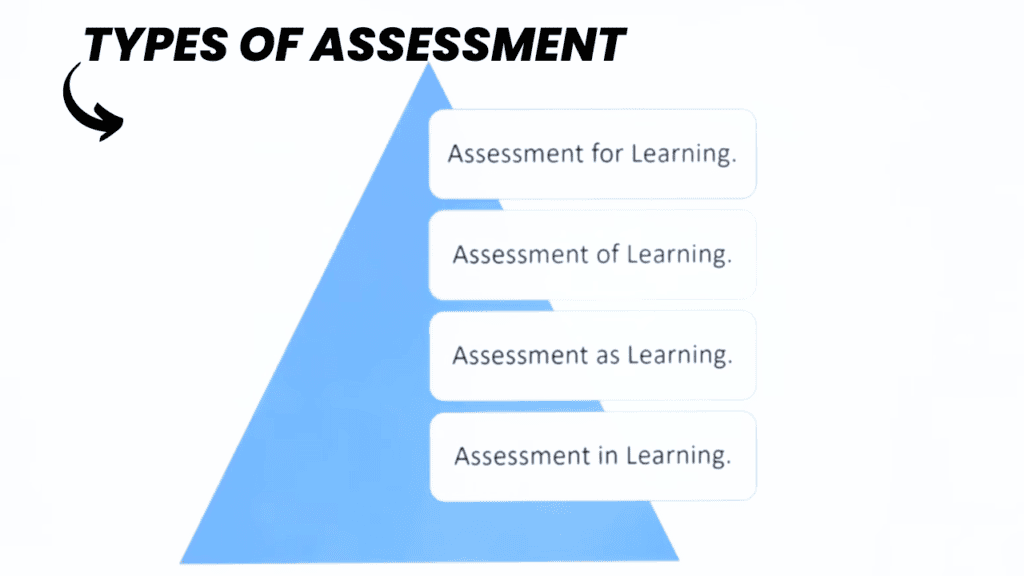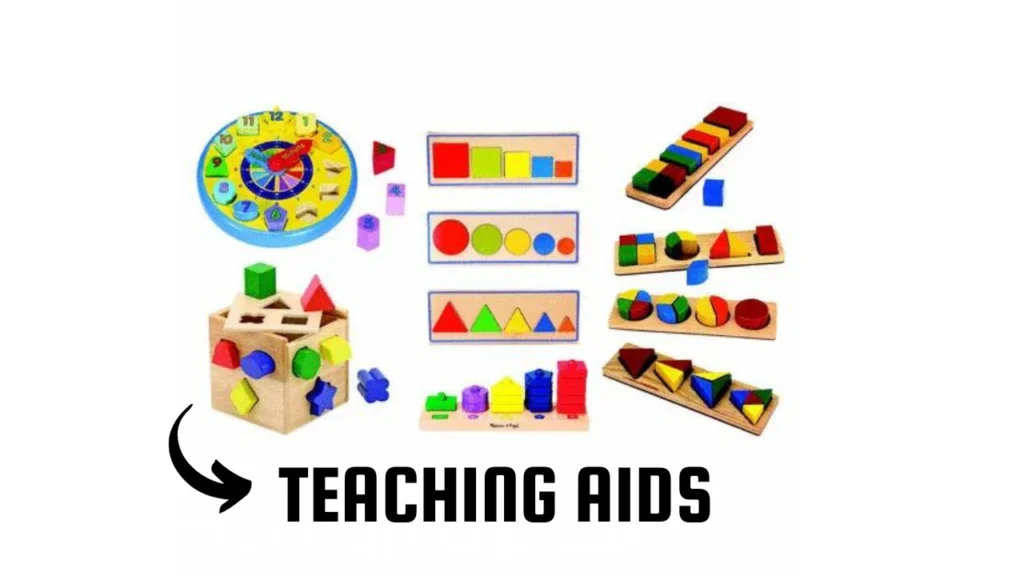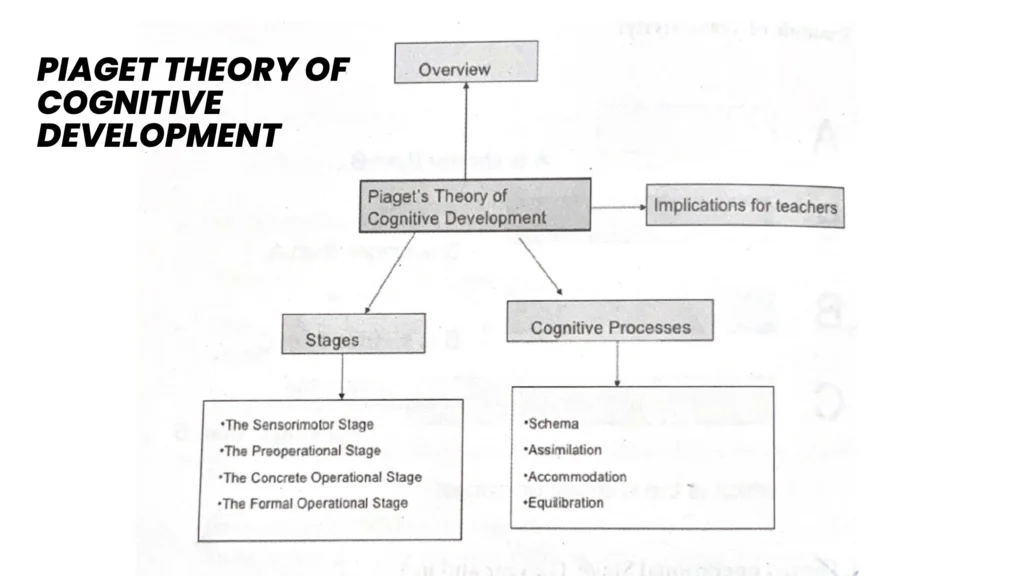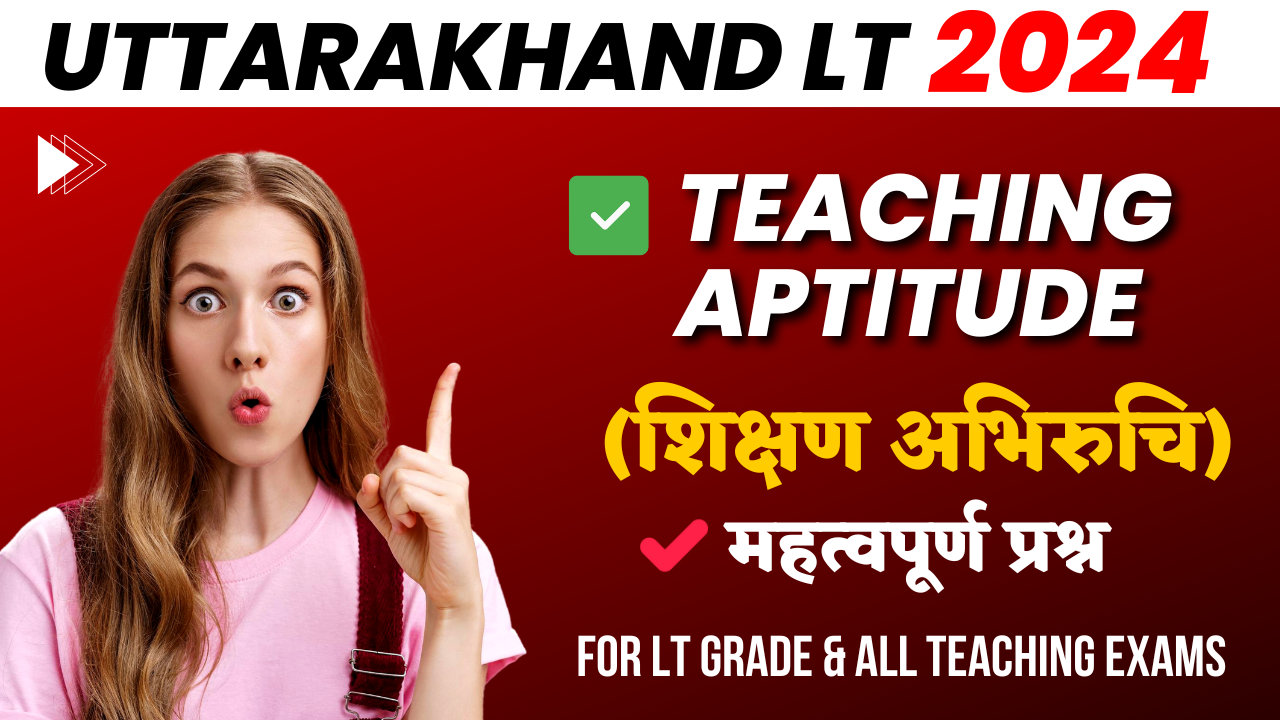Teaching Aptitude MCQ For uttarakhand LT Exam 2024 : उत्तराखंड में LT Exam की तैयारी कर रहे विद्यार्थियों के लिए शिक्षण अभिरुचि (teaching aptitude) बहुत ही महत्वपूर्ण विषय है जिसमें 30 अंकों के प्रश्न पूछे जाएंगे, अगर आप उत्तराखंड में लेक्चर बनना चाहते हैं तो उत्तराखंड एलटी एक्जाम 2024 के लिए अपनी तैयारी को मजबूत करने के लिए आपको teaching Aptitude के प्रश्नों को अच्छी तरीके से तैयार करने की जरूरत है ।
UKSSSC उत्तराखंड आयोग के द्वारा जुलाई माह में आईटी उत्तराखंड एग्जाम आयोजित किया जाएगा जिन भी अभ्यर्थियों ने इस परीक्षा के लिए आवेदन किया है वह अपनी तैयारी अभी से ही शुरू कर दें, इस परीक्षा को उत्तीर्ण करने के लिए आपके विषय से संबंधित प्रश्न पूछे जाएंगे इसके साथ ही शिक्षण अभिरुचि का भाग सभी विषयों के लिए सामान्य होगा । शिक्षण अभिरुचि के इन प्रश्नों के साथ आप अपनी परीक्षा की तैयारी को मजबूत कर सकते हैं और अच्छे अंक प्राप्त कर सकते हैं परीक्षा में जाने से पहले एक बार इन प्रश्नों को जरूर पढ़ें ।
Teaching Aptitude MCQ for Uttarakhand LT Exam 2024 | Uttarakhand LT Exam Syllabus | LT Exam Pattern | LT Exam 2024
Your Queries:
- Uttarakhand LT Exam 2024
- Teaching Aptitude MCQ in Hindi
- Uttarakhand LT Exam Teaching Aptitude Questions
- Teaching Aptitude For Uttarakhand LT Exam
- UKSSSC LT Exam Pattern
- Teaching Aptitude MCQ for Uttarakhand LT Exam
Q1. What is the primary goal of teaching?
a) Transmitting information
b) Enhancing critical thinking skills
c) Maintaining discipline in the classroom
d) Evaluating students’ performance
Answer: b) Enhancing critical thinking skills
Q1. शिक्षण का प्राथमिक लक्ष्य क्या है?
a) सूचना प्रसारित करना
b) आलोचनात्मक सोच कौशल को बढ़ाना
c) कक्षा में अनुशासन बनाए रखना
d) छात्रों के प्रदर्शन का मूल्यांकन करना
उत्तर: b) आलोचनात्मक सोच कौशल को बढ़ाना
Q2. Which teaching method encourages active student participation and hands-on learning?
a) Lecture method
b) Expository method
c) Inquiry-based learning
d) Demonstration method
Answer: c) Inquiry-based learning
Q2. कौन सी शिक्षण पद्धति छात्रों की सक्रिय भागीदारी और व्यावहारिक सीखने को प्रोत्साहित करती है?
a) व्याख्यान विधि
b) एक्सपोजिटरी विधि
c) पूछताछ-आधारित शिक्षा
d) प्रदर्शन विधि
उत्तर: c) पूछताछ-आधारित शिक्षा
Q3. What does the term “pedagogy” refer to in the context of teaching?
a) The science of teaching children
b) The art of teaching adults
c) The practice of classroom management
d) The assessment of student learning outcomes
Answer: a) The science of teaching children
Q3. शिक्षण के संदर्भ में “शिक्षाशास्त्र” शब्द का क्या अर्थ है?
a) बच्चों को पढ़ाने का विज्ञान
b) वयस्कों को पढ़ाने की कला
c) कक्षा प्रबंधन का अभ्यास
d) छात्रों के सीखने के परिणामों का मूल्यांकन
उत्तर: a) बच्चों को पढ़ाने का विज्ञान
Q4. Which of the following is NOT a characteristic of a good teacher?
a) Subject knowledge expertise
b) Authoritarian attitude
c) Empathy towards students
d) Effective communication skills
Answer: b) Authoritarian attitude
Q4. निम्नलिखित में से कौन सा एक अच्छे शिक्षक का लक्षण नहीं है?
a) विषय ज्ञान विशेषज्ञता
b) सत्तावादी रवैया
c) छात्रों के प्रति सहानुभूति
d) प्रभावी संचार कौशल
उत्तर: b) सत्तावादी रवैया
Q5. What does differentiated instruction involve?
a) Teaching the same content in the same way to all students
b) Adapting teaching strategies to meet the diverse needs of students
c) Focusing solely on gifted students in the classroom
d) Ignoring students’ individual learning styles
Answer: b) Adapting teaching strategies to meet the diverse needs of students
Q5. विभेदित निर्देश में क्या शामिल है?
a) सभी विद्यार्थियों को समान सामग्री समान तरीके से पढ़ाना
b) छात्रों की विविध आवश्यकताओं को पूरा करने के लिए शिक्षण रणनीतियों को अपनाना
c) कक्षा में केवल प्रतिभाशाली छात्रों पर ध्यान केंद्रित करना
d) छात्रों की व्यक्तिगत सीखने की शैलियों को नजरअंदाज करना
उत्तर: b) छात्रों की विविध आवश्यकताओं को पूरा करने के लिए शिक्षण रणनीतियों को अपनाना
Q6. What is the significance of formative assessment in the teaching-learning process?
a) It determines students’ final grades.
b) It helps in diagnosing students’ learning needs and adjusting instruction.
c) It is conducted at the end of a course or academic year.
d) It focuses on standardized testing.
Answer: b) It helps in diagnosing students’ learning needs and adjusting instruction.

Q6. शिक्षण-अधिगम प्रक्रिया में रचनात्मक मूल्यांकन का क्या महत्व है?
a) यह छात्रों के अंतिम ग्रेड निर्धारित करता है।
b) यह छात्रों की सीखने की जरूरतों का निदान करने और निर्देश को समायोजित करने में मदद करता है।
c) यह किसी पाठ्यक्रम या शैक्षणिक वर्ष के अंत में आयोजित किया जाता है।
d) यह मानकीकृत परीक्षण पर केंद्रित है।
उत्तर: b) यह छात्रों की सीखने की जरूरतों का निदान करने और निर्देश को समायोजित करने में मदद करता है।
Q7. Which teaching strategy focuses on fostering collaboration and teamwork among students?
a) Direct instruction
b) Cooperative learning
c) Drill and practice
d) Lecture method
Answer: b) Cooperative learning
Q7. कौन सी शिक्षण रणनीति छात्रों के बीच सहयोग और टीम वर्क को बढ़ावा देने पर केंद्रित है?
a) सीधा निर्देश
b) सहयोगात्मक शिक्षा
c) ड्रिल और अभ्यास करें
d) व्याख्यान विधि
उत्तर: b)सहयोगी शिक्षा
Q8. What does the term “scaffolding” mean in the context of teaching?
a) Providing temporary support to help students learn tasks that they cannot yet complete independently
b) Punishing students for not completing tasks
c) Ignoring struggling students
d) Relying solely on textbooks for instruction
Answer: a) Providing temporary support to help students learn tasks that they cannot yet complete independently
Q8. शिक्षण के संदर्भ में “मचान” शब्द का क्या अर्थ है?
a) छात्रों को उन कार्यों को सीखने में मदद करने के लिए अस्थायी सहायता प्रदान करना जिन्हें वे अभी तक स्वतंत्र रूप से पूरा नहीं कर सकते हैं
b) कार्य पूरा न करने पर विद्यार्थियों को दंडित करना
c) संघर्षरत छात्रों की उपेक्षा करना
d) शिक्षा के लिए केवल पाठ्यपुस्तकों पर निर्भर रहना
उत्तर: a) छात्रों को उन कार्यों को सीखने में मदद करने के लिए अस्थायी सहायता प्रदान करना जिन्हें वे अभी तक स्वतंत्र रूप से पूरा नहीं कर सकते हैं
Q9. Which of the following is an example of a summative assessment?
a) Classroom discussion
b) Homework assignments
c) Final exam
d) Peer evaluation
Answer: c) Final exam
Q9. निम्नलिखित में से कौन सा योगात्मक मूल्यांकन का उदाहरण है?
a) कक्षा चर्चा
b) होमवर्क असाइनमेंट
c) अंतिम परीक्षा
d) सहकर्मी मूल्यांकन
उत्तर: c) अंतिम परीक्षा
यह भी पढ़ें- Teaching Aptitude MCQ for LT Uttarakhand
Q10. What is the importance of reflective practice for teachers?
a) It allows teachers to take breaks during the day.
b) It helps teachers improve their teaching methods and strategies.
c) It involves solely theoretical discussions about teaching.
d) It focuses on criticizing students’ mistakes.
Answer: b) It helps teachers improve their teaching methods and strategies.
Q10. शिक्षकों के लिए चिंतनशील अभ्यास का क्या महत्व है?
a) यह शिक्षकों को दिन के दौरान ब्रेक लेने की अनुमति देता है।
b) यह शिक्षकों को उनकी शिक्षण विधियों और रणनीतियों को बेहतर बनाने में मदद करता है।
c) इसमें शिक्षण के बारे में पूरी तरह से सैद्धांतिक चर्चा शामिल है।
d) यह छात्रों की गलतियों की आलोचना करने पर केंद्रित है।
उत्तर: b) यह शिक्षकों को उनकी शिक्षण विधियों और रणनीतियों को बेहतर बनाने में मदद करता है।
Q11.Which of the following is an essential component of effective classroom management?
a) Maintaining strict discipline at all times
b) Allowing students to behave freely without rules
c) Establishing clear expectations and routines
d) Ignoring disruptive behavior
Answer: c) Establishing clear expectations and routines
Q11.निम्नलिखित में से कौन सा प्रभावी कक्षा प्रबंधन का एक आवश्यक घटक है?
a) हर समय सख्त अनुशासन बनाए रखना
b) छात्रों को बिना किसी नियम के स्वतंत्र रूप से व्यवहार करने की अनुमति देना
c) स्पष्ट अपेक्षाएं और दिनचर्या स्थापित करना
d) विघटनकारी व्यवहार को नजरअंदाज करना
उत्तर: c) स्पष्ट अपेक्षाएं और दिनचर्या स्थापित करना
Q12. What is the purpose of using visual aids in teaching?
a) To make the classroom more colorful
b) To entertain students during lessons
c) To enhance students’ understanding and retention of content
d) To replace verbal explanations entirely
Answer: c) To enhance students’ understanding and retention of content

प्रश्न12. शिक्षण में दृश्य सामग्री का उपयोग करने का उद्देश्य क्या है?
a) कक्षा को अधिक रंगीन बनाना
b) पाठ के दौरान छात्रों का मनोरंजन करना
c) छात्रों की सामग्री की समझ और अवधारण को बढ़ाने के लिए
d) मौखिक स्पष्टीकरणों को पूरी तरह से प्रतिस्थापित करना
उत्तर: c) छात्रों की सामग्री की समझ और धारणा को बढ़ाने के लिए
Q13. What is the significance of establishing rapport with students?
a) It helps teachers maintain authority in the classroom.
b) It fosters a positive learning environment and promotes student engagement.
c) It allows teachers to avoid interacting with students.
d) It has no impact on the teaching-learning process.
Answer: b) It fosters a positive learning environment and promotes student engagement.
Q13. छात्रों के साथ संबंध स्थापित करने का क्या महत्व है?
a) यह शिक्षकों को कक्षा में अधिकार बनाए रखने में मदद करता है।
b) यह एक सकारात्मक सीखने के माहौल को बढ़ावा देता है और छात्र जुड़ाव को बढ़ावा देता है।
ग\c) यह शिक्षकों को छात्रों के साथ बातचीत करने से बचने की अनुमति देता है।
d) इसका शिक्षण-अधिगम प्रक्रिया पर कोई प्रभाव नहीं पड़ता है।
उत्तर: b) यह एक सकारात्मक सीखने के माहौल को बढ़ावा देता है और छात्र जुड़ाव को बढ़ावा देता है।
Q14. What does the term “inquiry-based learning” entail?
a) Providing students with all the answers to their questions
b) Encouraging students to ask questions and investigate solutions
c) Ignoring students’ questions during lessons
d) Focusing solely on lectures without student participation
Answer: b) Encouraging students to ask questions and investigate solutions
प्रश्न14. “पूछताछ-आधारित शिक्षा” शब्द का तात्पर्य क्या है?
a) छात्रों को उनके प्रश्नों के सभी उत्तर प्रदान करना
b) छात्रों को प्रश्न पूछने और समाधान की जांच करने के लिए प्रोत्साहित करना
c) पाठ के दौरान छात्रों के प्रश्नों को नजरअंदाज करना
d) छात्रों की भागीदारी के बिना केवल व्याख्यानों पर ध्यान केंद्रित करना
उत्तर: b) छात्रों को प्रश्न पूछने और समाधान की जांच करने के लिए प्रोत्साहित करना
Q15. Which teaching method is characterized by students working independently on assigned tasks while the teacher provides individualized support and guidance?
a) Direct instruction
b) Flipped classroom
c) Blended learning
d) Differentiated instruction
Answer: d) Differentiated instruction
प्रश्न 15. किस शिक्षण पद्धति की विशेषता यह है कि छात्र स्वतंत्र रूप से सौंपे गए कार्यों पर काम करते हैं जबकि शिक्षक व्यक्तिगत समर्थन और मार्गदर्शन प्रदान करता है?
a) सीधा निर्देश
b) पलटी हुई कक्षा
c) मिश्रित शिक्षा
d) विभेदित निर्देश
उत्तर: d) विभेदित निर्देश
Q16. What is the purpose of assessment in education?
a) To rank students based on their performance
b) To provide feedback on students’ learning progress
c) To punish students for their mistakes
d) To intimidate students
Answer: b) To provide feedback on students’ learning progress
Q16. शिक्षा में मूल्यांकन का उद्देश्य क्या है?
a) छात्रों को उनके प्रदर्शन के आधार पर रैंक देना
b) छात्रों की सीखने की प्रगति पर प्रतिक्रिया प्रदान करना
c) छात्रों को उनकी गलतियों के लिए दंडित करना
d) छात्रों को डराना
उत्तर: b) छात्रों की सीखने की प्रगति पर प्रतिक्रिया प्रदान करना
Q17. What does the term “cognitive development” refer to in the context of education?
a) Physical growth of students
b) Emotional growth of students
c) Intellectual growth of students
d) Social growth of students
Answer: c) Intellectual growth of students

Q17. शिक्षा के संदर्भ में “संज्ञानात्मक विकास” शब्द का क्या अर्थ है?
a) विद्यार्थियों का शारीरिक विकास
b) विद्यार्थियों का भावनात्मक विकास
c) छात्रों का बौद्धिक विकास
d) छात्रों का सामाजिक विकास
उत्तर: c) छात्रों का बौद्धिक विकास
Q18. What is the role of a teacher in facilitating student learning?
a) To transfer knowledge to students
b) To inspire and guide students in their learning journey
c) To control and dominate classroom activities
d) To ignore students’ learning needs
Answer: b) To inspire and guide students in their learning journey
प्रश्न18. विद्यार्थियों के सीखने को सुविधाजनक बनाने में शिक्षक की क्या भूमिका है?
a) छात्रों को ज्ञान हस्तांतरित करना
b) छात्रों को उनकी सीखने की यात्रा में प्रेरित करना और मार्गदर्शन करना
c) कक्षा की गतिविधियों को नियंत्रित और हावी करना
d) छात्रों की सीखने की जरूरतों को नजरअंदाज करना
उत्तर: b) छात्रों को उनकी सीखने की यात्रा में प्रेरित करना और मार्गदर्शन करना
Read More- UKSSSC LT Grade Teacher 2024 | Mock Test Questions
